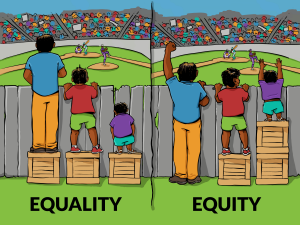
Pupils who come from less advantaged households, have English as a second language, and/or have a learning disability have historically faced a disproportionate number of obstacles in education. Since launching our ‘Inclusive Governance’ campaign, we’ve discussed the importance of equality and equity in governing landscapes – but what do these terms mean?
Put simply, equality means treating everyone the same way, irrespective of factors such as status or identity. Equity, on the other hand, means treating people differently in certain circumstances for equality of opportunity to be possible.
The below picture from the Interaction Institute for Social Change demonstrates that while equality means giving everyone access to the same resources, some people may not be able to utilise these resources due to factors outside of their control. As such, governing boards must put measures in place to ensure their actions are both equal and equitable so every pupil has the same experience.

Image created by Interaction Institute for Social Change (interactioninstitute.org) by artist Angus Maguire (madewithangus.com).
An example within a school might include giving every student access to a library but, if this library is on the third floor and the only way to get there is to use a staircase, students, staff and visitors with mobility problems would require an alternative way to get to that resource. In this situation, asking questions about adding a lift could lead to equity.
Providing equity might also include asking questions about how teachers can offer more support to students with learning difficulties or, whether your school could loan equipment such as laptops to students who don’t have access to these resources due to their socioeconomic backgrounds.
Catch up with the rest of our Inclusive Governance campaign
For more support on pushing for inclusive practices within your governing landscape, you can have a look at our campaign webpage. You can also follow us on ???? (formally Twitter), LinkedIn and/or Facebook for updates on the campaign.